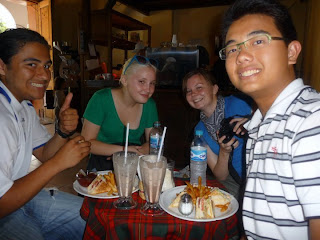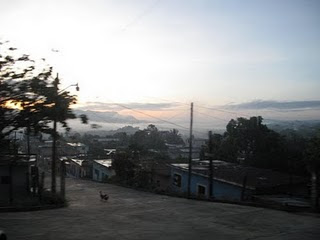We arrived in the village square, where a sizable crowd was gathered around a raised platform like a stage. Some of the local children were performing what appeared to be a healing ceremony, from what we could decipher of the banner hung above the stage. The kids were dressed in the traditional clothing of the highland Mayas: the girls with flowers in their hair, wearing embroidered blouses and black wool skirts secured around their wastes with colorful scarves; the boys wore white wool tunics, belted over trousers and a shirt. Ribbons of smoke swirled out of little pots of incense lining the front of the stage, as the kids chanted prayers in the Mayan dialect of Tzotzil while moving through a process of choreographed gestures. When they were finished, the crowd clapped and cheered, and the kids beamed with pride as they waved to their parents below.

It suddenly strikes me that in these people's history there have been others to come here and witness beautiful examples of community tradition like this one, and failed to see anything past the closed-minded notion that these people are different, and different is unacceptable. They called them "pagan," and used that word as justification to steal from, murder, and enslave them.
Despite this disturbing history, Chamula culture is still very much alive. On the town square stand the colorful Iglesia de San Juan Bautista, originally a Spanish mission church but is now an interesting blend of Catholicism and traditional, pre-conquest Mayan religion. Inside, cameras are not allowed. We walked in, silently, keeping our eyes down lest we look a Shaman in the face (this is considered very disrespectful). The floor is covered with pine needles, traditionally to represent the Mayan tree of life, but if you ask anyone they'll tell you they are to signify that Christ died on a pine cross. There are no pews. People kneel on the floor, chanting prayers in Tzotzil Mayan in front of rows of colored candles stuck to the floor with melted wax. Each color of candle represents a different thing such as sickness, the spirit, the soul, luck, purity, or the evil eye. They are prescribed by a shaman to treat a range of afflictions. Traditionally, worshippers would drink a fermented drink called posh, the subsequent burps believed to be the body releasing evil influences. Nowadays, posh has been largely replaced by soda -- particularly Coca-Cola. For particularly severe problems, a live chicken is sacrificed. We saw two chickens being sacrificed inside. Lining the walls are statues of Saints, their facial expressions full of emotion. They are now incased in glass for protection, as in the past they have been vandalized by people whose prayers have gone unanswered.

Outside the church, people send up their prayers in the form of bottle rockets. Traditionally, the Chamula live in thatched-roof huts. Occasionally, a firework will come back down and set one on fire. In recent years, the thatched roofs have slowly started to be replaced by tin ones.



The Chamula are an agricultural society, and their main staple is corn. This climate is relatively stable, so they can grow corn year round -- and they have been for thousands of years.
One of the problems that plagues the people here is protein deficiency in children. To treat this issue, a Shaman will take the sick child to different stations around down. Kneeling before the monumental crosses, they burn incense and chant prayers. At the last station, they sacrifice a chicken. The chicken is cooked and then eaten by the child and the Shaman, effectively solving the problem.
Crosses were important to the Maya long before Christianity ever came here. They represent the five cardinal directions: north, south, east, west, and center. This is also what the pyramids represent. Many crosses are adorned with pine branches, traditionally representing the mayan tree of life. You see carvings of trees with branches pointing in the shape of a cross at a lot of Mayan sites.... fortunately for them, it was a good way to fool the missionaries who otherwise might have made it harder on them. Fortunately for the missionaries, the conversion process was much easier, considering they were able to associate this and other familiar symbols with unfamiliar concepts. Some other examples: the moon, which to the Maya has for centuries represented the goddess of the underworld, the mother of fertility, to the crops and to the people, who gives life and takes it away, becomes representative of Mary as well; the sun, the father god and representative of the king, becomes Jesus. Sacrifice, something so important to the Maya, becomes embodied by the crucified Christ. Judas is not scorned for his betrayal, but commended -- for taking responsibility for his actions. For maintaining his dignity by killing himself, rather than be killed by another or dying of old age which would have been a continuation of his selfish ways.
These are all examples of what anthropologists call syncretism: the blending and overlapping of different schools of thought, particularly as relating to religion, between a dominant culture and an oppressed culture. Here's a quick, good article on Mayan religion, and some of the ways it has incorporated / interpreted traditional Catholicism.
We spent the day at the village, exploring the streets and beautiful countryside. I had some fun at the market, bartering and communicating as best I could with people with whom our only link in communication was the bits and pieces of Spanish we both knew. . . :D I did manage to buy a pretty awesome bag, and a rosary for my mom. For lunch we had some delicious fire-grilled corn, seasoned with spicy salt and lime, bought from a small market stand.

We headed back to San Cristobal as it was starting to get dark. When we got back, Yoshi, Howie, Sam and I decided to go to out for milkshakes and discovered an awesome little shop on the Zocolo called Cafe Yik. As we were sitting, three young boys came in and, pulling small ceramic animals out of their baskets, they laid them out one by one on the table, "elefante, jaguar, tortuga.....," I bought one from each of them, for three pesos each, only to be scolded again by Howie, who thinks I'm much too easily chided by the cute small ones. (He's probably right...!)











































